Knowing how to talk about wine in English is a useful skill, whether you’re ordering a bottle at an elegant restaurant in New York or doing a structured wine tasting in Napa, California. If you can describe a wine’s color, flavor, texture and aroma with better accuracy, you’ll be able to find wines that perfectly suite your palate. You’ll also have a richer experience the next time you visit wine country!
Lista di vocaboli
- Palate: in questo contesto, i propri gusti e preferenze.
- Wine country: le regioni vitivinicole.
- Straw: colore paglia.
- Copper: colore rame.
- Ruby: colore rosso rubino.
- Garnet: colore granata.
- Tawny: colore fulvo.
- Inky: avere un aspetto che ricorda l’inchiostro, cioè scurissimo e quasi opaco.
- To swirl: far ruotare/roteare il vino nel bicchiere.
- On the nose: la qualità olfattiva.
- Herbaceous/vegetal: ha l’aroma o il sapore di erbe aromatiche o piante verdi.
- Mouthfeel: la sensazione del vino in bocca.
- Full-bodied: corposo.
- Stems: gli steli d’uva.
- Fizzy: frizzante, gassato.
- Varietal: un vitigno.
- ABV: (abbreviazione) “Alcohol by Volume.” La quantità di alcool in una bevanda, misurata in percentuale.
- Fortified wines: i vini liquorosi.
- To pucker: in questo esempio, quando la bocca si arriccia per l’acidità.
- Hold up to aging: la capacità di invecchiare in bottiglia.
- Lush: succoso.
- Tangy: agro, acido, saporito.
- Flavor profile: l’insieme degli elementi del vino, ad esempio i gusti, profumi, consistenza, terroir, ecc.
- Clay soil: terreno argilloso.
- Silt: terreno sabbioso.
- A clean finish: le sensazioni gusto-olfattive durano poco; il vino è corto.
- A long finish: le sensazioni gusto-olfattive permangono a lungo; il vino è persistente.
- A velvety finish: il vino è vellutato in bocca e questa sensazione dura a lungo.
Ascolta la Registrazione
Leggi il testo
How to describe wine in english.
Because wine is a multi-sensory experience, you’ll want to be able to describe not just its flavor, but other aspects like color, clarity, aroma, texture, and finish. Today I’ll share with you some vocabulary to help you do this. I’ve organized it into four groups according to the basic steps of a typical wine tasting:
- Visual analysis.
- Olfactory analysis.
- Taste analysis.
- Questions for the winemaker.
1. VISUAL ANALYSIS:
How to describe the wine's Color and clarity.
ANALISI VISIVA:
Come descrivere in inglese il colore e la chiarezza del vino
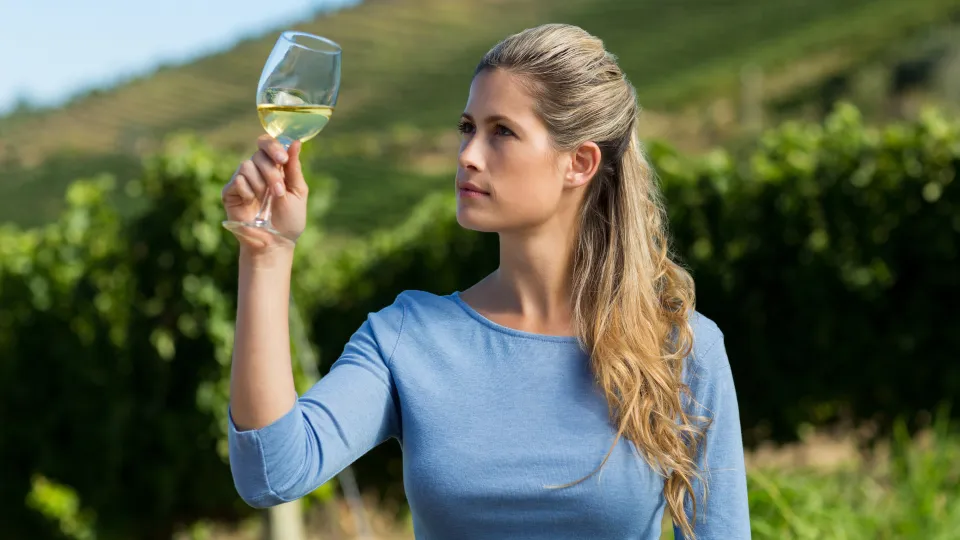
In order to do a proper visual analysis of the wine, you’ll first want to hold your wine glass up to the light to check for clarity. Then, place the wine glass in front of a white background to appreciate the wine’s true color. Here are some words to describe how a wine looks:
Clarity
- clear
- cloudy
- opaque
Color intensity
- pale
- medium
- deep
Colors
White wines
- straw
- yellow
- gold
- amber
Red wines and rosés
- copper
- salmon colored
- pink
- ruby
- garnet
- purple
- tawny
- inky
Here is an excellent chart that shows examples of each color.
2. OLFACTORY ANALYSIS:
How to describe the wine's bouquet.
ANALISI OLFATTIVA:
Come descrivere in inglese il bouquet del vino

In order to do a proper olfactory analysis, you should first swirl the wine in the glass to release the aromas. A wine’s bouquet is impacted by the region’s unique terroir, the barrels used in aging, and the grapes themselves. Here are a few categories of aromas you might detect on the nose of a wine.
- fruity
- floral
- earthy
- spiced
- herbaceous/ vegetal
- nutty
- chemical
3. TASTE ANALYSIS:
How to describe the wine's texture, alcohol content, acidity, flavor, and finish.
Analisi GUSTATIVA:
Come descrivere in inglese la consistenza, il contenuto alcolico, l'acidità, il sapore, e il retrogusto del vino.

Texture
Body
This is the most basic way to talk about a wine’s texture, or mouthfeel. Full-bodied wines are said to have more structure and complexity than lighter-bodied wines.
- full-bodied
- medium-bodied
- light-bodied
Tannins
Wines that are made from grapes that have thicker skins, or were grown in warmer climates are often more tannic. The length of time a wine spends in the barrel, and how much contact it has had with the skins, seeds, and stems of the grapes also impacts tannicity. Here are some adjectives to describe tannins:
Wine with lighter tannins can be described as:
- delicate
- silky
- rounded
- velvety
- polished
Wines with stronger tannins can be described as:
- firm
- heavy
- chewy
- astringent (usually negative connotation)
Effervescence
Here are some words to describe how fizzy the wine is:
- still (no bubbles)
- semi-sparkling (in pratica, come un vino frizzante)
- sparkling (in pratica, come uno spumante)
Alcohol Content
Alcohol content can vary drastically from one varietal to another. According to alcohol.org, a moscato only has around 5-7% ABV, while a zinfandel or a shiraz can have up to 18% ABV. Fortified wines such as port or madeira can have even more alcohol: up to 21% ABV! It would be uncommon to ask a sommelier for a wine with a specific ABV, but you could absolutely let them know whether you’d like:
- a low alcohol content
- a medium alcohol content
- a high alcohol content
Acidity
Acidity is what gives wines that tartness that makes our mouths pucker. Not only is it important for balancing the tannins and flavors of the wine, it also helps the wine hold up to aging. If a wine has insufficient acidity, not only will it taste less flavorful, it won’t age as well. Here are some adjectives you can use to describe a wine’s acidity:
Low acidity:
- lush
- flat (negative connotation)
- dull (negative connotation)
Medium acidity:
- moderate
- fresh
High acidity:
- bright
- crisp
- mouth-watering
- tangy
- lively
- sharp
Sweetness
You can describe a wine’s sweetness as:
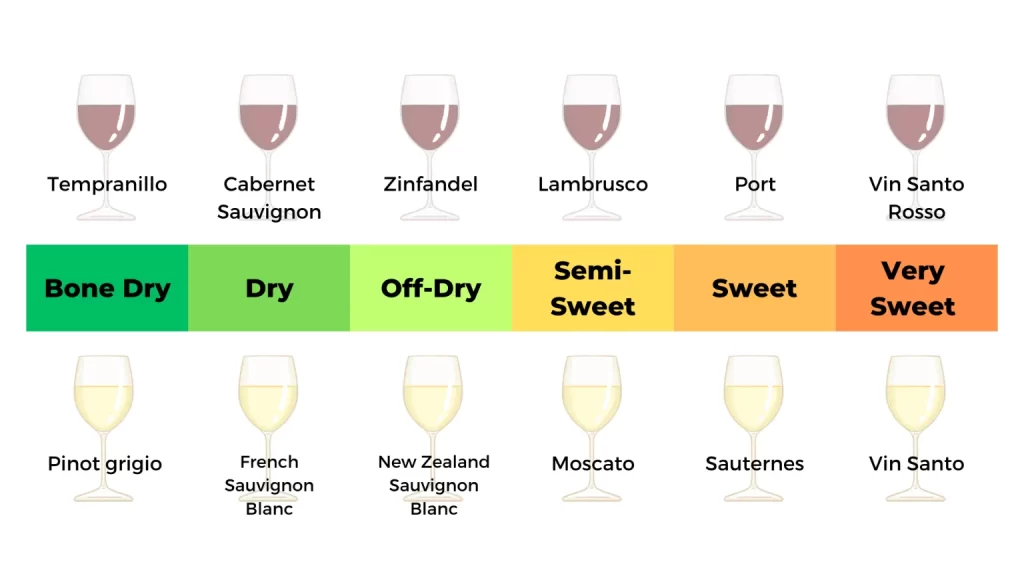
Flavor
Each type of wine tends to to have a distinct flavor profile that is characteristic of the varietal, however there are hundreds of factors that can change the flavor of a wine. These include unusual weather patterns, what types of fermentation tanks are used (stainless steel tanks, concrete tanks, versus wooden vats), and of course soil type (clay soil, volcanic soil, chalky soil, silt, etc.).
Fruity flavors
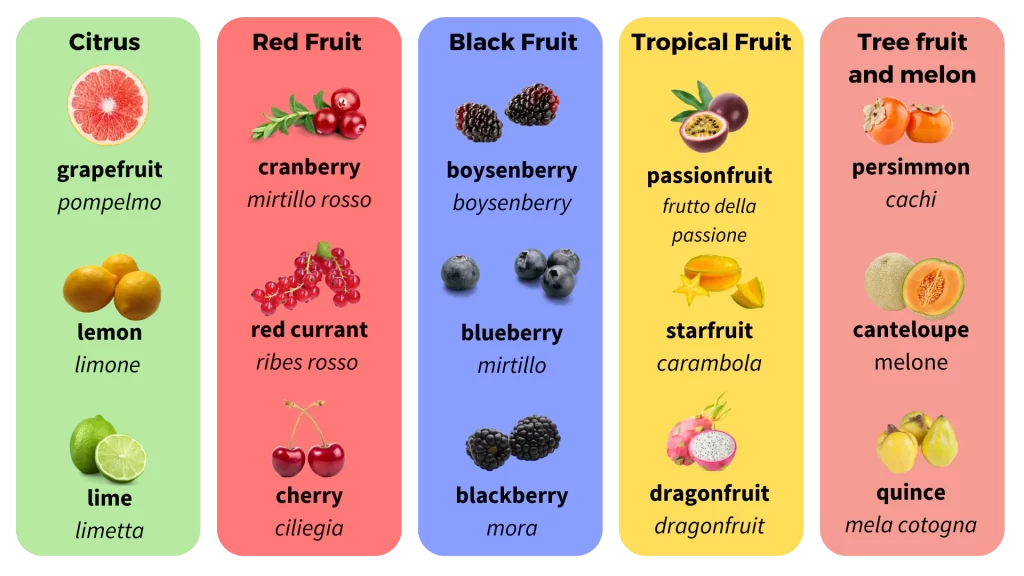
Herbaceous flavors

Earthy, mineral, floral, and sweet flavors

Other flavors you might taste
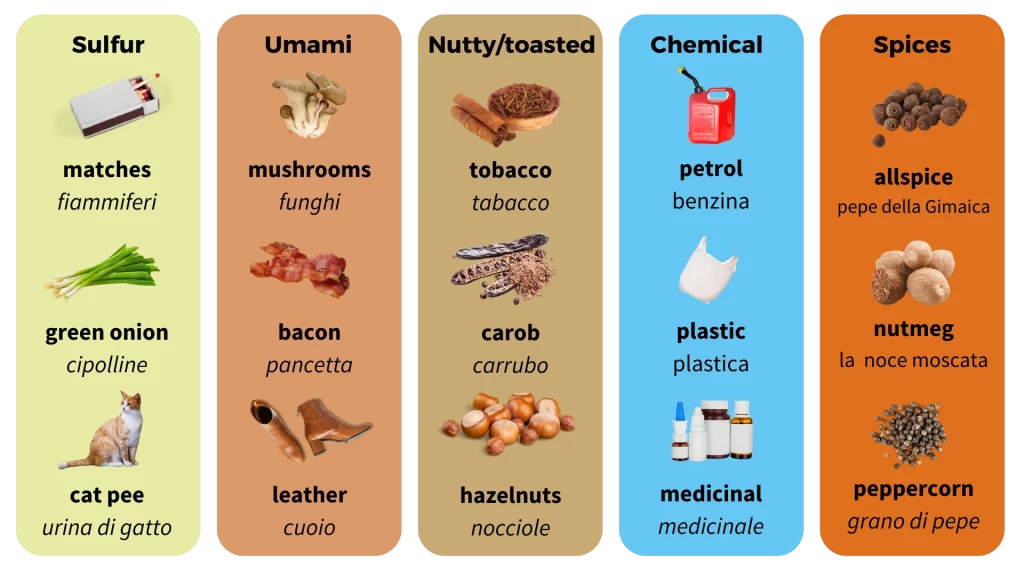
The Finish
This refers to how long a wine’s texture and flavors last in your mouth before they fade. Here are some ways to describe a wine’s finish:
- A clean finish means that the flavors are fresh and distinct, and fade quickly.
- A long finish means the flavors and texture last a long time.
- A velvety finish means a long finish in which the tannins make the inside of your mouth feel like velvet.
4. Questions you can ask about wine.
Esempi di domande da fare in inglese sul vino
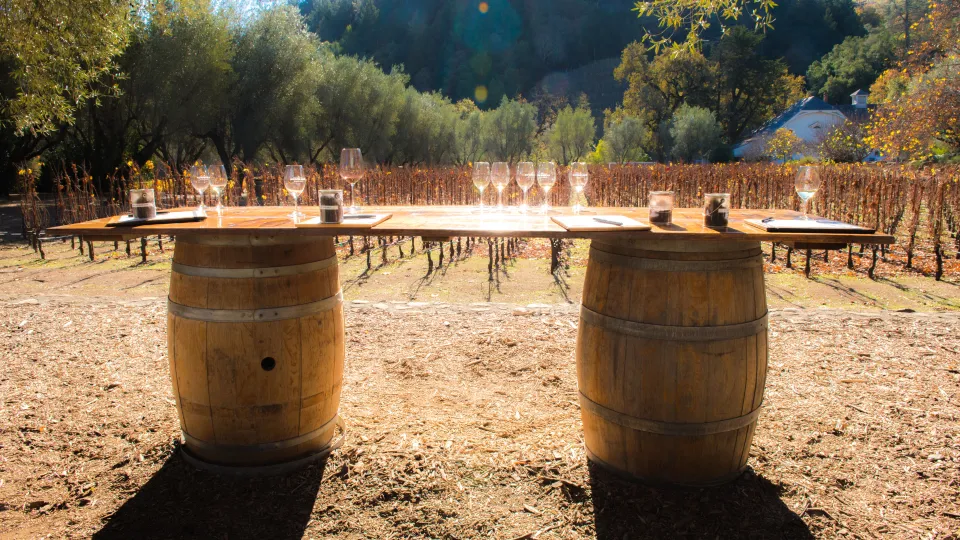
What’s the soil like in this region? How does this affect the flavor?
Com’è il terreno in in questa zona? In che modo influenza il sapore del vino?
Is this wine estate grown?
Questo vino è prodotto con uva coltivata esclusivamente dal proprio vigneto?
What kinds of flavors should I expect in this wine?
Quali sapori mi aspetterei di trovare in questo vino?
What kinds of foods would pair best with this wine?
Quali sono i migliori cibi a cui abbinare questo vino?
Is it better to drink this wine now, or let it age it a few years?
Questo vino, è meglio berlo adesso, o lasciarlo invecchiare qualche anno?
How did the weather affect this vintage?
In che modo il clima ha influenzato quest’annata?

Sono Curiosa...
- È comune per gli italiani andare in compagna per degustare i vini nei vigneti nel proprio paese, o è questo una cosa strettamente turistica?
- Secondo te, in quale regione del mondo si fanno i migliori vini? Mi puoi suggerire un vigneto specifico?
- Cosa ne pensi di questo testo? Troppo facile? Troppo difficile? Quali sono le parole che non sapevi prima?
Fammi sapere nei commenti!
Feedback is always Welcome
Mi faccio in quattro per rendere questo sito d’aiuto. Quindi, se hai qualsiasi feedback o se vuoi che io scriva su un tema o su una parola particolare in inglese, dimmelo nei commenti, oppure sentiti libero di darmi un suggerimento, cliccando qui.
Iscriviti alla newsletter!

Mi raccomando, iscriviti alla newsletter in modo da incoraggiarti a leggere i post per non perdertene neanche uno. Così l’apprendimento diventerà più facile e efficace. Ti prometto di non sommergerti di mail superflue.



